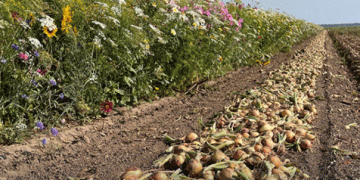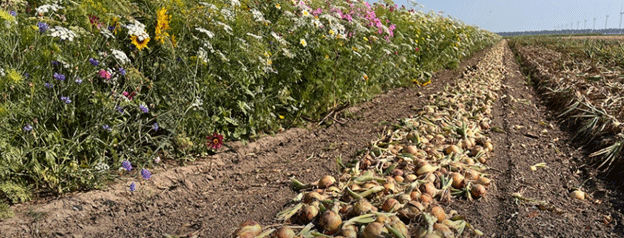As the onion harvest season draws to a close, attention shifts from the fields to storage, where farmers must carefully manage their crop to ensure it retains its quality until it reaches the market. According to agricultural expert Kees Jacobs, while some regions have reported good yields, several factors—ranging from late planting to disease outbreaks—could negatively impact the overall quality of onions this season. In this article, we discuss the challenges faced by farmers and the steps necessary to mitigate risks during storage.
Quality and Yield: The Current Outlook
Onion quality has been mixed this year. Though some regions like Flevoland and Drenthe are reporting decent yields, the expected harvest is falling short of predictions. Jacobs notes that across many fields, yields are lower due to weather events such as heavy rain and hail, coupled with insufficient sunlight during the growing season. On some fields, these unfavorable conditions have reduced yields by 10-15 tons compared to normal expectations.
Additionally, the average size of harvested onions is smaller than anticipated. This is problematic for both farmers and the market, as larger onions generally command a higher price, and a smaller crop can result in lower overall returns for producers.
Managing Bacterial Infections and Other Diseases
One of the most pressing concerns this season is the higher prevalence of bacterial diseases. According to Jacobs, bacterial infections are more widespread than in previous years. These diseases can enter onion crops through damaged tissue—often the result of hail or wind—and spread further through animal activity, such as hares grazing on fields.
Once infected, onions show visible signs such as browning and premature ripening. If left untreated, these onions will soften and emit an unpleasant odor, reducing their market value. Farmers are advised to carefully monitor their crops in the field and during the curing process. Affected bulbs should be removed to prevent further spread, and care should be taken during harvesting to minimize mechanical damage.
The Importance of Proper Drying
Drying is one of the most important steps in maintaining onion quality during storage. Jacobs recommends using supplemental heat to aid the drying process, as relying solely on outside air is often insufficient, particularly in damp or cool conditions. By using hot air, farmers can ensure a steady drying temperature of 20-22°C, which helps prevent water stains and other moisture-related issues.
An additional tool that farmers should consider is a relative humidity (RH) meter. Monitoring RH levels is crucial for determining when onions are fully dried. Jacobs advises continuing the drying process until RH drops to 60%. Once this level is reached, the onions are safe to store. However, if the RH begins to rise above 80% during storage, corrective action—such as additional heating—should be taken to avoid spoilage.
Ensuring Long-Term Storage Success
After onions have been thoroughly dried, careful attention must be given to cooling. Jacobs recommends a gradual cooling rate of 1.5°C per week, which allows the onions to acclimate slowly, reducing the risk of quality degradation. He also emphasizes that onions must be monitored throughout storage, as fluctuating temperatures and humidity levels can still cause sprouting or decay.
A final word of advice relates to MH spraying, a common practice used to inhibit sprouting in onions. Jacobs notes that the effectiveness of this treatment may have been compromised in some areas due to downy mildew, which hastened the death of onion plants. To assess whether MH treatment was successful, farmers can conduct a simple test: placing onion samples on moist soil at 15-20°C and checking for sprouting after a few weeks.
While the growing season presented many challenges for onion farmers, especially with the reduced yield and bacterial infections, the post-harvest period offers a crucial opportunity to preserve quality and profitability. By following best practices in drying, disease management, and storage, farmers can reduce the risk of crop loss and maintain the value of their onions until they reach the market.
































